Young challengers take a deep dive into engineering
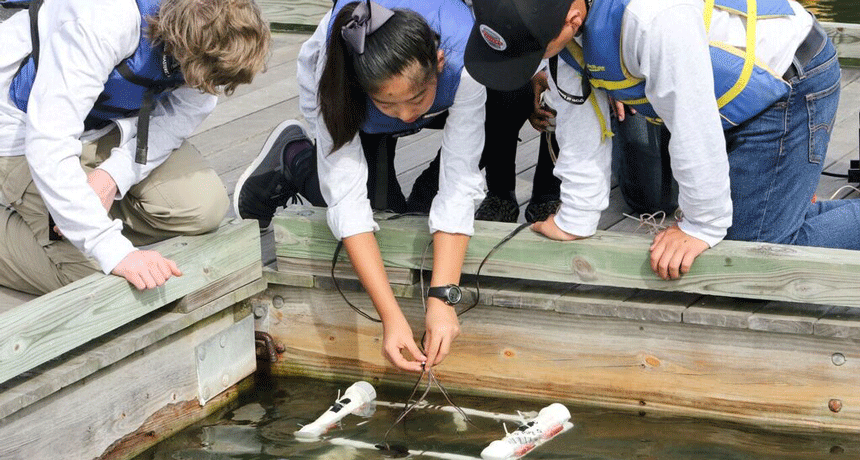
WASHINGTON, D.C. — Sometimes a job is too dirty, dangerous or downright impossible for a human to tackle. That’s often when engineers build a machine to take on the task. Finalists at this year’s Broadcom MASTERS competition were presented with just such a challenge. They had to design and build a small remotely-operated vehicle (ROV) that could dive to a river bottom and bring back a sample of the sediment. Adding to the challenge, they had only a few short hours to do it.
Broadcom MASTERS brings together 30 middle-school finalists each year for a special competition. (MASTERS stands for Math, Applied Science, Technology and Engineering for Rising Stars.) The program was created by Society for Science & the Public, which publishes Science News for Students. Broadcom Foundation, based in Irvine, Calif., sponsors the event. The top winner, this year, took home an educational award valued at $25,000. Others took home smaller, but still substantial, prizes.
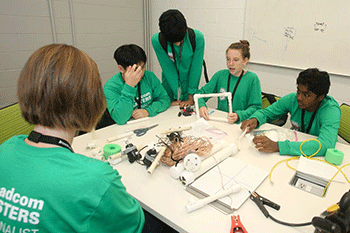
In contrast to most science competitions, roughly three-quarters of a finalist’s score at this event comes from how well he or she innovates and works within a team. Only about one-fourth of a finalist’s total score reflects the science-fair project that qualified each for the competition (and which they presented to judges earlier in the week).
This year, each of the six teams of finalists faced stiff challenges. They built electronic circuits that lit up when a rolling ball completed the circuit. They devised ways to filter tainted water “on Mars.” But their final and most demanding test was creating a sediment-collecting ROV.
The task at hand
Engineering is a process that uses math, science and practical knowledge to invent, design, build and improve structures, machines, materials and more. This year’s toughest challenge for Broadcom MASTERS finalists required them to tap into their inner engineers.
They worked at the Smithsonian Environmental Research Center, or SERC, in Edgewater, Md. This center sits along the shore of the Rhode River, a short waterway that flows into the Chesapeake Bay. When last year’s group of Broadcom MASTERS finalists went to the site, they built a robotic arm based on a crab’s claw. This year’s group had an equally hands-on task.
Whitman Miller, an environmental scientist at SERC, gave the finalists background on their mission. He has worked with engineering students at the nearby U.S. Naval Academy to design and build a small unmanned craft that can sail near to shore. It doesn’t have one hull that extends deeply into the water. Instead, it has three hulls that are connected in an arrangement that looks like an outrigger canoe.
That craft is not yet finished. Indeed, its final design is “up in the air,” so to speak. Still, Miller has a few ideas about how it will look when complete.
Motors that propel and steer the craft (and the batteries to power them) will sit in the smaller hulls on each side of the main one. That main hull in the center of the craft will likely carry scientific instruments, including sensors. It also will carry navigation equipment along with the small computers needed to control the sensors. Miller and his team will be able to swap out sensors and other equipment, depending on which task the craft is dispatched to tackle.
When done, the craft will be able to carry out missions without human input, says Miller. For example, it might collect sediment from shallow waters near shore. Such areas are usually inaccessible to large boats, which have hulls too deep to sail there. The craft might use a global positioning system (GPS) to navigate. No human assistance would be needed as the craft operates. Such programmable, hands-off vehicles are called autonomous (Aw-TAH-nuh-mus). Sometimes researchers send out autonomous underwater vehicles, or AUVs, to perform repetitive tasks, such as mapping the seafloor.
Other types of underwater vehicles are designed to go where crews at the surface guide them, Miller notes. These ROVs usually are controlled via signals sent to the craft along wires. Sometimes, images from cameras or data gathered by other sensors on the craft flow back to the people controlling the craft. That sort of real-time feedback can help controllers guide the craft throughout its mission.
ROVs have explored shipwrecks, such as the Titanic. They’ve also been used to explore the ecosystems around deep-sea hydrothermal vents.
The Broadcom finalists’ task would be a lot simpler. They had to design an ROV that would dive a little more than 2 meters (about 7 feet) beneath the water’s surface and bring up a sample of sediment from the river bed. After Miller’s brief intro, the finalists got a look at the materials they could use to build their vehicles.
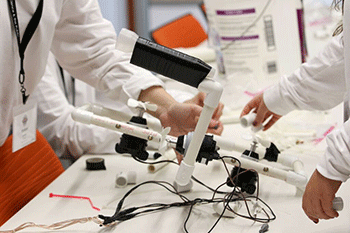
Down to work
The finalists worked in teams of five. Each was named for a color. (The finalists had been assigned to those teams before they arrived in Washington. And each of these groups had already worked on challenges as a team at this year’s competition.)
Each team was supplied a bucket of parts. There were rolls of tape and pieces of plastic pipe of various lengths, along with some L-shaped and T-shaped plastic connectors. The young engineers also got spoons and sponges, which could be used to pick up sediment. Among the most important things in the bucket were a trio of small motors, a switchbox to control them and a battery pack to power them.
The teens initially spent about a half hour designing their ROVs. Next, the teams took a short break for lunch. Although, for most teams, lunch wasn’t much of a break. Many competitors spent a lot of that time discussing and tweaking their design.
Afterward, the students were given 90 minutes to build — and, in some cases, tear apart, rebuild and build yet again — those ROVs. Some ended up with a box-like configuration. Others looked more like a picture frame with an arm sticking out and holding a scoop.
The building phase was challenging. The teams were working in an office building far from water. They had no idea whether the device they were assembling would float like a boat or sink like a rock. They also couldn’t tell whether their ROV would be balanced and level in the water, or if it would tilt strongly to one side. Such issues could affect where on their ROV the team placed its motors.
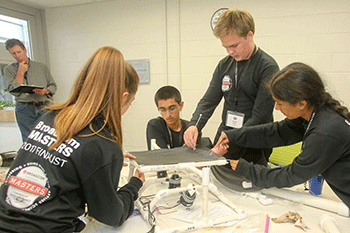 )
)
Finally, the teams were shuttled down to SERC’s dock. There they got a chance to test their vehicles. On this cloudy yet calm day, each group claimed a short stretch of dock. From there, they eased their ROVs into the water. Over the next 90 minutes or so, the teams continued to tweak their designs. This time they made changes with clear evidence of their ROVs’ abilities — or lack thereof.
In some cases, the engineers might ditch a plan to scoop sediment with a spoon. Instead they’d redesign the system — successfully — to collect sediment with a sponge. One team’s frame-shaped design was poorly balanced at first. The students struggled to arrange their motors. Eventually — after quite a few tries — they found a design that worked.
In the end, every craft brought up at least a small bit of the Rhode River’s fine-grained sediment.
As each team later described its design to the others, the students shared some of the lessons they would take home. These included: “Never let go of an idea, even if it doesn’t work right away.” “We found several ways to collect sediment that worked.” “Our design doesn’t look great, but it works!”
Karen McDonald is an environmental scientist at SERC. She hosted and led the ROV challenge. After the teams had briefed each other on their prototype vehicles, she praised them for their efforts. “I saw some great teamwork and some great designs,” she said.
SERC’s Miller agreed: “I was impressed with what the teams were able to do in just three hours,” he said. “Technology is moving so quickly now, but it’s also more accessible to people who aren’t professional engineers.”
Power Words
(for more about Power Words, click here)
autonomous Acting independently. Autonomous vehicles, for instance, pilot themselves based on instructions that have been programmed into their computer guidance system.
battery A device that can convert chemical energy into electrical energy.
Broadcom MASTERS Created in 2011 by the Society for Science & the Public, Broadcom MASTERS (Math, Applied Science, Technology and Engineering Rising Stars) is the premier middle school science and engineering fair competition. Broadcom MASTERS International gives select middle school students from around the world a unique opportunity to attend the Intel International Science & Engineering Fair.
circuit A network that transmits electrical signals. In the body, nerve cells create circuits that relay electrical signals to the brain. In electronics, wires typically route those signals to activate some mechanical, computational or other function.
ecosystem A group of interacting living organisms — including microorganisms, plants and animals — and their physical environment within a particular climate. Examples include tropical reefs, rainforests, alpine meadows and polar tundra.
engineer A person who uses science to solve problems. As a verb, to engineer means to design a device, material or process that will solve some problem or unmet need.
feedback A response or assessment that follows some a particular act or decision.
filter (in chemistry and environmental science) A device or system that allows some materials to pass through but not others, based on their size or some other feature. (in physics) A screen, plate or layer of a substance that absorbs light or other radiation or selectively prevents the transmission of some of its components.
global positioning system Best known by its acronym GPS, this system uses a device to calculate the position of individuals or things (in terms of latitude, longitude and elevation — or altitude) from any place on the ground or in the air. The device does this by comparing how long it takes signals from different satellites to reach it.
hull (in transportation) The main body of a large or heavy vehicle, such as a boat or tank. (in botany) The outer shell or coat of a fruit or a seed.
hydrothermal vent An opening at the bottom of the ocean or a lake where hot water emerges from deep inside Earth. The water is rich in minerals and chemicals that can nourish ecosystems of worms, clams, microbes and other organisms.
innovation (v. to innovate; adj. innovative) An adaptation or improvement to an existing idea, process or product that is new, clever, more effective or more practical.
motor A device that converts electricity into mechanical motion. (in biology) A term referring to movement.
navigate To find one’s way through a landscape using visual cues, sensory information (like scents), magnetic information (like an internal compass) or other techniques.
programmable A device or system that contains a computer, which allows the functions to change in a prescribed way, usually as determined by the user or manufacturer.
remotely operated vehicle (or ROV) An electrically powered craft that is tethered to something above the water, usually a ship. People operate this craft from a remote location. Because these vehicles don’t need a pilot onboard, then can go places that are inhospitable for people, such as the very deep ocean.
sediment Material (such as stones and sand) deposited by water, wind or glaciers.
sensor A device that picks up information on physical or chemical conditions — such as temperature, barometric pressure, salinity, humidity, pH, light intensity or radiation — and stores or broadcasts that information. Scientists and engineers often rely on sensors to inform them of conditions that may change over time or that exist far from where a researcher can measure them directly. (in biology) The structure that an organism uses to sense attributes of its environment, such as heat, winds, chemicals, moisture, trauma or an attack by predators.
technology The application of scientific knowledge for practical purposes, especially in industry — or the devices, processes and systems that result from those efforts.
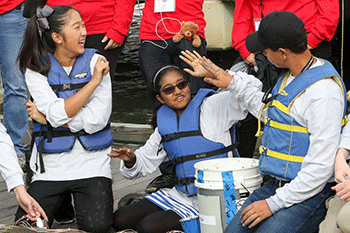
I hope to follow me in steemit https://steemit.com/@hamanibzd
Congratulations @hamanibzd! You received a personal award!
Click here to view your Board of Honor
Do not miss the last post from @steemitboard:
Thanks ✌️✌️
Congratulations @hamanibzd! You received a personal award!
You can view your badges on your Steem Board and compare to others on the Steem Ranking
Vote for @Steemitboard as a witness to get one more award and increased upvotes!
Thanks team steemit 🙏